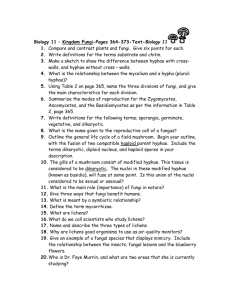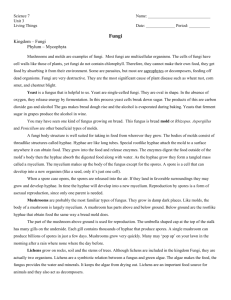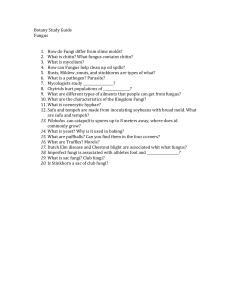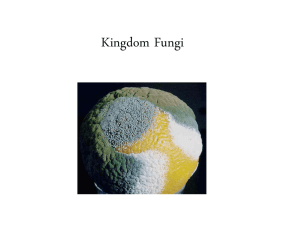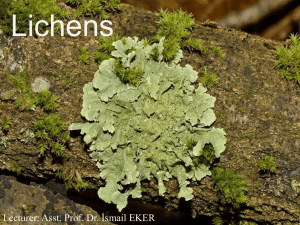Chapter 31
advertisement
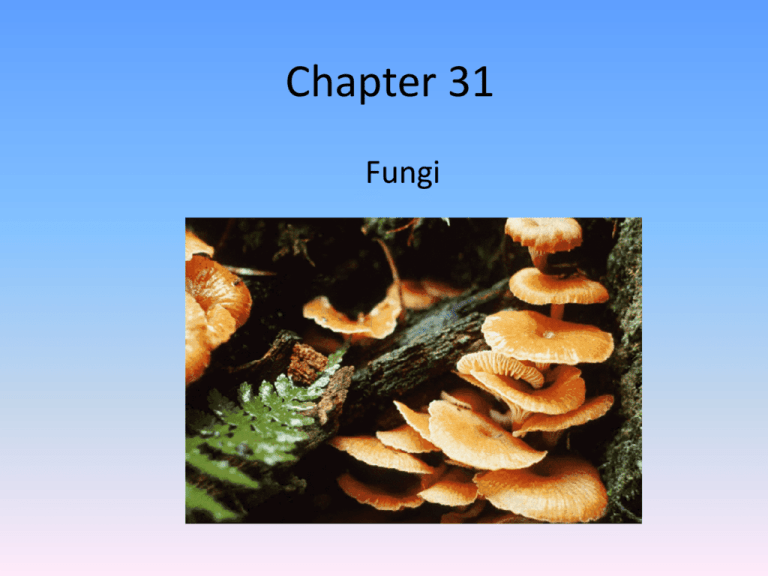
Chapter 31 Fungi Intro to Fungi • Eukaryotes • Most are multicellular • Were once thought to be plants – Recent molecular studies show that they are more closely related to animals than plants Nutrition • Heterotrophs that acquire nutrients by absorption – Small organic molecules are absorbed from surrounding medium • Digests food outside of body by secreting enzymes on the food – Exoenzymes: decompose complex molecules into more simple compounds Nutrition • Saprobes (decomposers) – Absorb nutrients from nonliving organic matter • Parasites – Absorb nutrients from living hosts • Some infect lungs of humans • Fungi cause 80% of plant disease • Mutualistic symbionts – Absorb nutrients from a host but provide functions beneficial to their partners • Aiding a plant in the uptake of minerals from the soil Structure • Vegetative bodies are usually hidden around and within their food sources • Constructed of hyphae – Thin filaments that are composed of tubular walls surrounding plasma membranes and cytoplasm – Form an interwoven mat called mycelium • Feeding network of a fungus • Can be extremely large but hidden because it is subterranean • 2000: found the mycelium of one individual fungus in Oregon that is 3.4 miles in diameter and spreads through 2200 acres – Equivalent to over 1600 football fields • It is at least 2400 years old and hundreds of ton in weight – One of Earth’s oldest and largest organisms Structure • Hyphae are divided into cells by cross-walls, or septa – Have pores large enough to allow ribosomes, mitochondria, and nuclei to flow from cell to cell • Cell walls made of chitin • Some don’t have septa – Coenocytic fungi consist of a continuous cytoplasmic mass with hundreds to thousands of nuclei • Resulted from the repeated division of nuclei without cytoplasmic division Structure • Parasitic fungi have their hyphae modified as haustoria, which are tips that penetrate the tissues of the host plant – There are even fungi with hyphae that are adapted to feed on animals Structure – Function Relationship • Filamentous structure of the mycelium provides an extensive surface area that assists the absorptive function of fungi – Mycelium can grow as much as a kilometer of hyphae each day as it branches out throughout a food source Reproduction • Release spores that are produces either sexually or asexually – Amount of spores is tremendous • Puff balls can put out trillions of spores – Spores function as dispersal agents – Airborne spores of fungi have been found more than 100 miles above Earth Heterokaryotic Stages • Nuclei of fungal hyphae and spores are haploid, except for transient diploid stages that form during sexual life cycles • Some mycelia become genetically heterogeneous through the fusion of two hyphae that have genetically different nuclei = heterokaryon – Different nuclei may stay separate or join in a “crossing over” occasion Sexy Fungus • Plasmogamy: the fusion of the two parents’ cytoplasm when their mycelia come together • Karyogamy: fusion of the haploid nuclei contributed by the two parents – These stages may be separated by hours or even centuries – During interim, the hybrid exists as a heterokaryon Diversity • More than 100,000 species are known, and there are estimated 1.5 million species worldwide • Fungi are broken down into four phyla: – Chytridiomycota – Zygomycota – Ascomycota – Basidiomycota Chytridiomycota • “Chytrids” are mainly aquatic • Some are saprobes, others parasitize protists, plants, and animals – Contributing to the worldwide decline of amphibians • Form coenocytic hyphae • Most primitive of fungi – Diverged earliest in the lineage of fungi Chytridiomycota Zygomycota • 600 different species • Terrestrial and live in soil or on decaying organic matter • Mycorrhizae: mutualistic associations with the roots of plants • Hyphae are coenocytic • Ex: Black Bread Mold Mycorrhizae Black Bread Mold Ascomycota • • • • 60,000 different species “Sac Fungi” Marine, freshwater, and terrestrial Include some of the most devastating plant pathogens • Live with algae to form lichens • Produce sexual spores in a saclike asci Ascomycota Basidiomycota • 25,000 species – Include mushrooms • “Club Fungus” • Decomposers of wood and other plant material • Long-lived dikaryoric mycelium – Reproduces sexually by producing basidiocarps, which are the source of sexual spores So…. When you eat mushrooms, you are eating Fungal Genitalia…. “Fairy Rings” • A ring of mushrooms • Grass in center is stunted because the mycelium is using all the nutrients Other Categories of Fungi • • • • Molds Yeasts Lichens Mycorrhizae Molds • Rapidly growing, asexually reproducing fungus • Saprobes or parasites • Mold is a mold if it is in the asexual stage – Later will turn into zygo, asco, or basidiomycotas • Imperfect Fungi – Have no sexual stages whatsoever Yeasts • Unicellular fungi that inhabit liquid or moist habitats, including plant sap and animal tissues • “Bud” to reproduce • Raise bread and ferment alcohol – Metabolically active and release small CO2 bubbles or ferment sugars to alcohol • pH shift or immunodeficiency can lead to “yeast infections” where normal yeast populations have exponential growth Yeast Lichens • Often mistaken for mosses or plants • Symbiotic association of millions of photosynthetic microorganisms held in a mesh of fungal hyphae – Algae provide fungus with food – Bacteria in lichens fix nitrogen and provide organic nitrogen – Fungus provides alga with a suitable environment for growth • Absorb nutrients from dust in the air or from rain Lichens • Important pioneers on newly cleared rock and soil surfaces – Burned forests and volcanic flows • Lichens make it possible for a succession of plants to grow • Can tolerate severe cold and desiccation – Reindeer moss – Can absorb more than ten times their weight in water Lichens Mycorrhizae • “Fungus Roots” • Extensions greatly increase the absorptive surface of the plant roots • Exchange minerals accumulated from soil by the fungus for organic nutrients synthesized • Occur on almost all vascular plants • Show up as mushrooms at the base of trees Ecological Impact • Principal decomposers – Without them, carbon, nitrogen, and other elements would become ties up in organic matter • 10-50% of world’s fruit harvest is lost each year due to fungus • During the Revolutionary War, British lost more ships to fungal rot than to enemy attack Ecological Impact • Pathogenic: – – – – 30% of fungus is parasitic, mainly on plants Dutch Elm: Killed ALL American Chestnut trees Some release toxins that are carcinogenic: Aspergillus Ergot poisoning: gangrene, nervous spasms, hallucinations • One epidemic killed more than 40,000 people in France in 944 A.D. – One chemical from ergots is the raw material that LSD is made • Helpful in treating high blood pressure and stopping maternal bleeding after childbirth when given in small doses Ecological Impact • Mycosis: fungal infection – – – – Ringworm Athletes foot Histoplasmosis- causes tuberculosis-like symptoms Opportunistic infections • Only capable of occurring because body is not in homeostasis or the immune response is lowered – Yeast infections • Food – Cheeses – Colas – Truffles • Use pigs to locate them because they give off a smell that mimics female pig pheromones Evolution of Fungi • Oldest fossils of vascular plants have fungus on them – 460 million years ago • Fungal ancestors were aquatic flagellated organisms • There is compelling evidence that animals and fungi diverged from a common protistan ancestor


